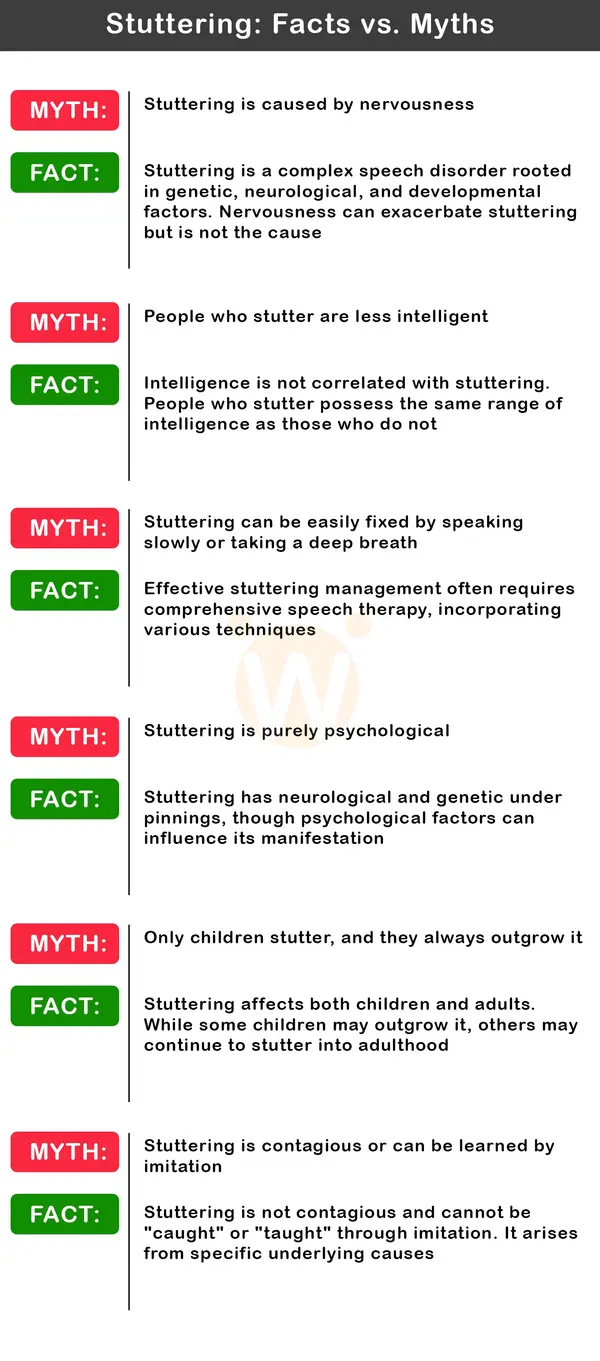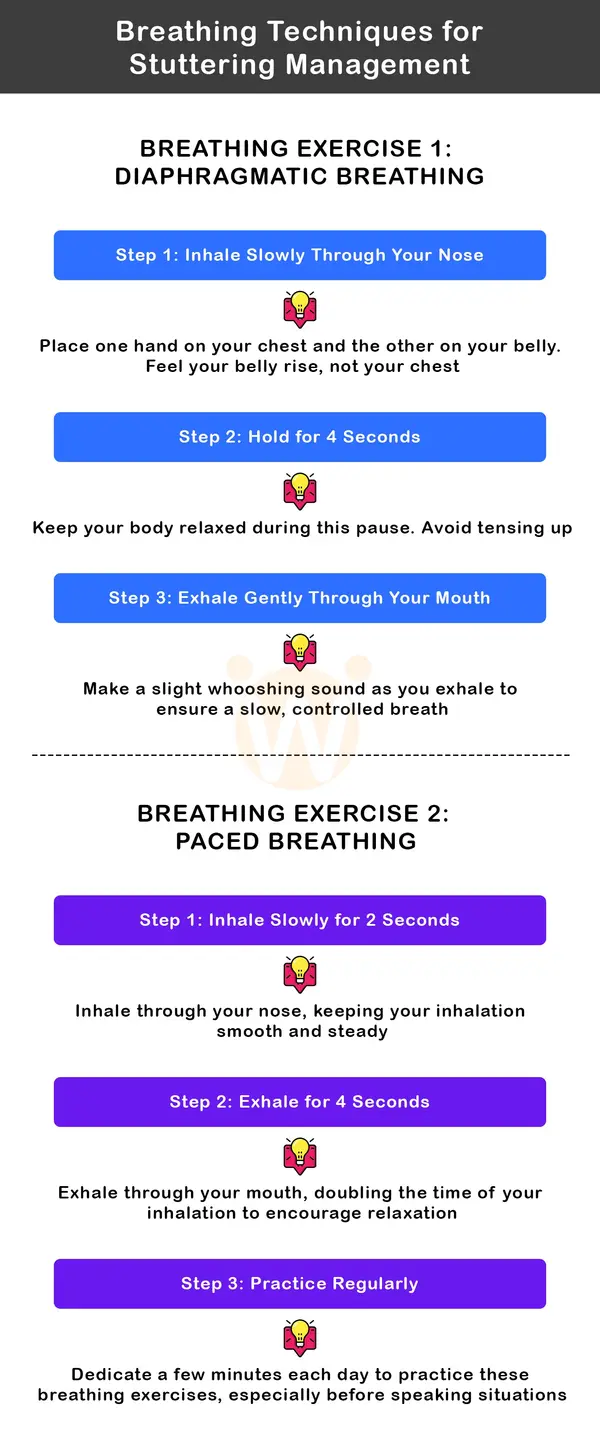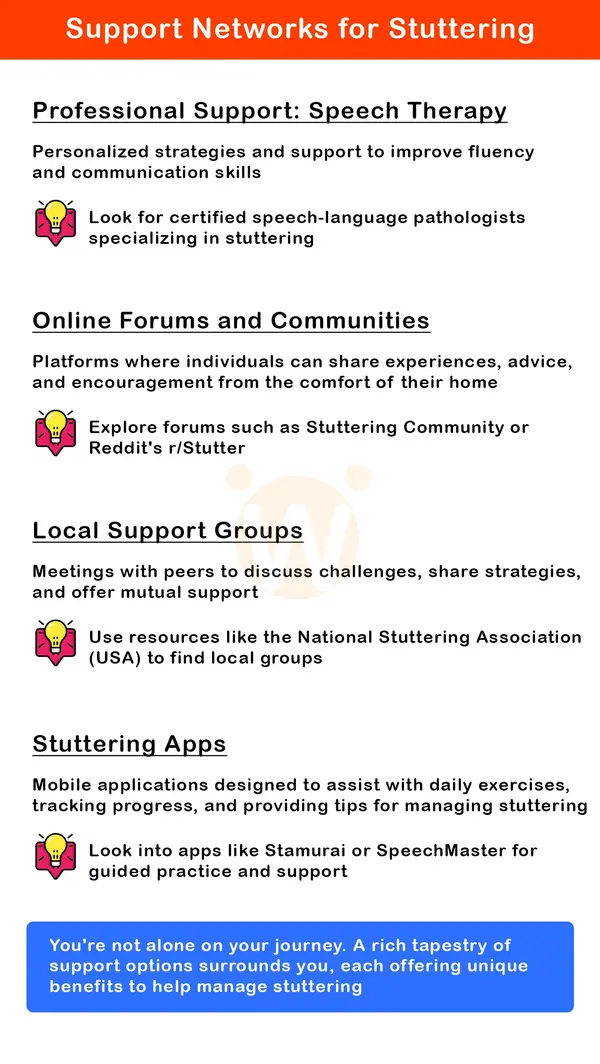How to Talk Confidently When You Stutter in Public
By Rajini D
Last Updated: February 22, 2024
Stuttering is a word that might seem small but carries a vast world of experiences, challenges, and emotions for many. It’s a common speech disorder that affects people across ages, impacting not just the way they communicate but also how they see themselves in the mirror of society. Stuttering can be a companion from childhood or can visit someone in their later years, but its presence is felt deeply by those who experience it.
You might have found yourself in situations where words seem to get stuck, where your voice doesn’t flow as you wish. Or perhaps you’ve watched a loved one navigate the complex journey of living with a stutter. It’s more common than you think, touching lives silently yet profoundly.
Why focus on fear and tension?
Because they’re not just symptoms of stuttering but often amplifiers. Breaking this cycle can be transformative, not only for your speech but for your overall well-being and confidence. And that’s exactly what we aspire to guide you through.
Understanding Stuttering and Its Emotional Impact

Stuttering, often interchanged with the term stammering, refers to a common speech disorder marked by disruptions in the flow of speech. These disruptions can include repetitions of words or parts of words, prolongations, and blocks that interrupt the natural rhythm of speaking. While some differentiate between stuttering and stammering based on cultural or regional preferences, the essence of the experience remains the same: a challenge in producing fluid speech.
This condition goes beyond the physical manifestations of disrupted speech patterns. The emotional and psychological impact of stuttering is profound, affecting individuals’ self-esteem, social interactions, and overall quality of life. Many who stutter experience a range of negative feelings, from fear and anxiety to embarrassment and social withdrawal. These emotions can create a vicious cycle, where the dread of stuttering in social situations exacerbates the frequency and severity of stuttering episodes, further increasing anxiety and fear.
To understand more about the emotional and mental health considerations associated with speech disorders, our detailed guide on Mental Health offers insights and support.
The Link Between Fear, Tension, and Stuttering
The relationship between fear, tension, and stuttering is complex and deeply interwoven. Fear of speaking in public, fear of judgment, and the anticipation of stuttering can lead to increased muscle tension and anxiety. This heightened state of tension, in turn, can worsen stuttering, creating a feedback loop that’s challenging to break. Research indicates that this cycle can be mitigated through various strategies aimed at reducing fear and tension, thereby managing stuttering more effectively.
Experts in the field of speech therapy emphasize the importance of addressing not only the physical aspects of stuttering but also the psychological components. Techniques designed to manage anxiety and reduce tension, such as deep breathing, mindfulness, and positive visualization, have been shown to improve speech fluency in individuals who stutter. These methods, part of a comprehensive approach to stuttering management, offer hope and practical solutions for those seeking to speak more easily and with greater confidence.
Incorporating these strategies into daily routines can significantly impact the lives of people who stutter, offering them relief from the cycle of fear and tension that often accompanies their condition. Whether it’s through professional therapy, support groups, or self-guided exercises, taking steps to manage the emotional aspects of stuttering is a critical component of effective stuttering management.
Explore our article on Ways to Fight Your Fears: How to Overcome Fear for additional strategies to manage anxiety related to stuttering.
Practical Strategies for Overcoming Fear and Tension
Embarking on a journey to manage to stutter is not just about learning to speak more fluently; it’s about transforming your relationship with your speech. Here, we explore practical strategies that can significantly reduce the fear and tension associated with stuttering, guiding you toward a more confident and comfortable speaking experience.
Acceptance and Mindset Shift
The first step in overcoming stutter is not about changing how you speak but changing how you think about stuttering. Acceptance is key. Recognize that stuttering is a part of your speech pattern, but it doesn’t define who you are or diminish your worth. Embracing this aspect of yourself can alleviate the pressure to speak perfectly, which paradoxically can improve fluency. Remember, overcoming stuttering, and the fear associated with it starts with self-acceptance and understanding that stuttering is just one part of your unique self.
Read more about the power of acceptance in our article on Gratitude and Its Benefits: Why Should You Practice Gratitude in Life.
Breathing Techniques and Relaxation Exercises

Tension, especially in the muscles involved in speaking, can exacerbate stuttering. Learning to relax these muscles through breathing techniques and relaxation exercises can be incredibly beneficial. Try deep breathing exercises: inhale slowly through your nose, hold your breath for a few seconds, and then exhale gently through your mouth. This simple exercise can significantly reduce speech tension. Incorporating regular relaxation practices like yoga or meditation can also help manage overall anxiety related to speech.
For a deep dive into breathing and relaxation techniques that can aid speech fluency, our article on Mastering Bilabial Sounds in Children: A Parent’s Guide provides useful exercises.
Positive Visualization and Role-Playing
Visualization and role-playing are powerful tools for overcoming the fear of stuttering. Start by visualizing a successful speaking situation. Picture yourself speaking fluently, feeling confident, and being received positively by your audience. This mental rehearsal prepares your mind for successful speaking experiences. Following visualization, engage in role-playing exercises. Practice speaking scenarios with a trusted friend or family member or even in front of a mirror. This practice builds confidence and reduces the fear associated with various speaking situations.
Enhance your practice with our insights on Visual Schedules to support speech development.
Effective Strategies for Managing Stuttering
| Strategy | Benefits | How to Start |
|---|---|---|
| Acceptance | Reduces self-imposed pressure to speak perfectly and increases self-esteem. | Acknowledge stuttering as a part of your speech pattern, not your identity. Reflect on personal experiences and feelings about stuttering in a journal. |
| Breathing Exercises | It Lowers speech tension, promotes relaxation, and improves vocal control. | Practice deep breathing exercises daily, focusing on slow, deliberate inhalations and exhalations. Use mindfulness or meditation apps to guide you. |
| Positive Visualization | It Enhances confidence, reduces speaking anxiety, and prepares for successful speaking scenarios. | Visualize successful speaking scenarios daily, focusing on the emotions and sensory experiences of speaking fluently and confidently. |
| Role-Playing | Builds speaking skills in a controlled environment and reduces fear of real-life speaking situations. | Practice speaking scenarios with a trusted friend or family member, or record yourself to replay and analyze. |
| Professional Help | Provides personalized strategies and support and addresses both physical and emotional aspects of stuttering. | Research and contact speech therapists specializing in stuttering. Many offer virtual sessions if in-person options are not feasible. |
| Support Groups | It Offers emotional support, reduces feelings of isolation, and allows sharing of experiences and strategies. | Join online forums or local support groups for people who stutter. Websites like the National Stuttering Association (USA) provide listings. |
Speech Therapy and Support Groups

Professional help can make a significant difference in managing stuttering. Speech therapists offer personalized strategies and techniques designed to improve fluency. They can also help address the psychological aspects of stuttering, providing a comprehensive approach to managing the condition. Additionally, joining a support group for people who stutter can provide a sense of community and belonging. Sharing experiences and tips with others who understand the challenges of stuttering can be incredibly supportive and empowering.
Are there effective ways to speak fluently despite stuttering? Absolutely. The journey to improved fluency and reduced fear and tension involves a combination of acceptance, practice, professional guidance, and community support. Each of these strategies offers a step towards not only managing stuttering but also embracing your voice and speaking with confidence.
Also read: Unlocking Communication: Effective Speech Therapy for Autism
Incorporating Wellness Hub Into Your Journey
As we navigate the path to managing stuttering, having a supportive and resourceful partner can make all the difference. This is where Wellness Hub steps in—not as the centerpiece of your journey but as a steadfast companion offering tools, support, and resources that align with the strategies we’ve discussed.
Wellness Hub is designed to complement your efforts in overcoming stuttering, fear, and tension. Whether you’re exploring breathing techniques, seeking practical exercises for positive visualization, or looking for community support, Wellness Hub offers a range of resources to assist you. Our platform includes access to apps focused on relaxation and mindfulness, articles with actionable tips, and connections to speech therapy professionals and support groups.
Discover our Online Speech Therapy services for more personalized support.
Engaging with the Reader: Tips for Daily Practice
Incorporating new strategies into daily life requires patience, persistence, and a positive mindset. Here are some actionable tips to help you practice and progress on your journey to fluent speech:
- Set Realistic Goals: Start with small, achievable goals that focus on gradual improvement. Celebrate every step forward, no matter how minor it may seem.
- Daily Practice: Dedicate time each day to practice your breathing exercises, speech techniques, or visualization exercises. Consistency is key to making progress.
- Reflect on Your Progress: Keep a journal of your speaking experiences and note any improvements or challenges. Reflection can provide valuable insights into your journey and help you adjust your strategies as needed.
- Seek Feedback: Engage with friends, family, or members of your support group to get constructive feedback on your speaking. Sometimes, an outside perspective can highlight improvements you might not have noticed yourself.
- Celebrate Small Victories: Every time you notice improvement, take a moment to celebrate. These small victories are significant milestones on your path to overcoming stuttering.
For more tips on developing good learning and practice habits, consider our article on Tips to Develop Good Learning Habits.
Stuttering Management: Weekly Progress and Challenge Log
| Week | Progress Highlights | Challenges Faced | Strategies Implemented | Next Week’s Goals |
|---|---|---|---|---|
| 1 | Noticed less tension during morning breathing exercises. | Struggled with visualization techniques. | Focused more on creating detailed scenarios for visualization. Increased duration gradually. | To comfortably complete visualization exercises and start incorporating positive affirmations. |
| 2 | Successfully visualized two speaking scenarios confidently. | Hesitation in role-playing exercises with a partner. | Practiced solo role-playing to build confidence before engaging with a partner. | Engage in role-playing with a partner and attend one support group session. |
| 3 | Participated in a support group and shared experiences. | Felt anxious about implementing techniques in real-life situations. | Discussed anxiety with the support group and sought advice. Started small, with less intimidating speaking situations. | Apply breathing and visualization techniques in two real-life speaking situations. |
| 4 | Used techniques in real-life situations with some success. | Encountered setbacks in more stressful speaking scenarios. | Analyzed the situations post-event to understand triggers and prepared more targeted role-plays. | Focus on managing stress in challenging speaking scenarios and continue regular support group participation. |
For additional resources on managing stuttering and improving speech fluency, visit our section on Speech and Language Therapy.
Conclusion
Throughout this journey, we’ve explored the multifaceted nature of stuttering, delving into its emotional impact, the interplay between fear, tension, and speech disruptions, and practical strategies to manage and reduce these challenges. By embracing acceptance, engaging in targeted exercises, seeking professional guidance, and drawing strength from supportive communities, individuals who stutter can make significant strides towards smoother, more confident speech.
The path to managing stuttering is as unique as the individuals walking it. It’s a journey marked by ups and downs, successes, and learning opportunities. Yet, the underlying message is one of hope and empowerment. With the right approach, tools, and support, the impact of stuttering on one’s life can be profoundly reduced, opening up new avenues for personal and professional growth.
As we draw this guide to a close, we invite you to continue exploring, practicing, and discovering the strategies that resonate most with you. Remember, Wellness Hub is here to support you every step of the way. Our platform is rich with resources, from articles and apps to professional directories and community forums, all designed to aid you on your journey to confident communication.
We encourage you to visit the Wellness Hub for more information, support, and inspiration. Whether you’re looking for practical tips, seeking to connect with others who understand your experiences, or searching for professional guidance, you’ll find a welcoming community ready to support you.
Frequently Asked Questions:
1. What is stuttering, and how is it different from stammering?
Stuttering, also known as stammering in some regions, refers to a speech disorder characterized by repetitions, prolongations, or blocks that interrupt the flow of speech. The terms are often used interchangeably, with “stuttering” more commonly used in the United States and “stammering” more prevalent in the United Kingdom.
2. Can fear and anxiety cause stuttering?
While fear and anxiety do not cause stuttering, they can exacerbate it. Individuals who stutter often experience heightened tension and anxiety in speaking situations, which can worsen stuttering symptoms, creating a cycle of fear and speech disruptions.
3. Are there effective ways to manage stuttering?
Yes, there are several effective strategies to manage stuttering. These include acceptance and mindset shifts, breathing techniques and relaxation exercises, positive visualization and role-playing, and seeking support through speech therapy and support groups.
4. How can breathing exercises help with stuttering?
Breathing exercises help reduce speech tension by promoting relaxation of the muscles involved in speaking. Techniques like deep breathing can calm the nervous system, making it easier to speak more fluently and with less effort.
5. What role does positive visualization play in managing stuttering?
Positive visualization involves picturing yourself speaking fluently and confidently in various situations. This mental rehearsal can prepare your brain for successful speaking experiences, reducing fear and building confidence.
6. Why is acceptance important in overcoming stuttering?
Accepting stuttering as a part of your speech pattern can alleviate the pressure to speak perfectly, which paradoxically can lead to improvements in fluency. Acceptance encourages a healthier relationship with speech and reduces the emotional burden of stuttering.
7. How can Wellness Hub support individuals who stutter?
Wellness Hub offers a variety of resources, including articles, apps, and access to professional therapy and support groups, to help individuals manage stuttering. The platform provides tools and community support to complement personal strategies for managing stuttering.
8. Can stuttering be completely cured?
While there is no universal cure for stuttering, many individuals can significantly improve their speech fluency and confidence through targeted strategies, therapy, and practice. The focus is on managing symptoms and reducing the impact of stuttering on daily life.
9. How does role-playing help in overcoming fear and tension associated with stuttering?
Role-playing is a powerful technique that simulates real-life speaking situations in a controlled environment, allowing individuals to practice speaking skills and confront their fears in a safe space. It helps build confidence, improve communication strategies, and reduce anxiety about actual speaking events by preparing the individual for various scenarios and responses.
10. Can joining a stuttering support group make a difference in managing stuttering?
Absolutely. Joining a stuttering support group provides individuals with a sense of community and understanding. Sharing experiences and strategies with others who face similar challenges can offer emotional support, reduce feelings of isolation, and provide practical tips for managing stuttering.
About the Author:
Rajini, Speech-Language Pathologist:
M.Sc., Speech-Language Pathologist (9+ years of experience)
Rajini is a passionate and dedicated Speech-Language Pathologist with over 9+ years of experience, specializing in both developmental speech and language disorders in children and rehabilitation in adults. Driven by a desire to empower each individual to find their voice, Rajini brings a wealth of experience and a warm, genuine approach to therapy.
Currently, at Wellness Hub, she thrives in a team environment that values innovation, compassion, and achieving results for their clients.
Connect with Rajini to learn more about how she can help you or your loved one find their voice.
Book your Free Consultation Today
Parent/Caregiver Info:
Client’s Details:
* Error Message









